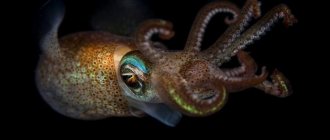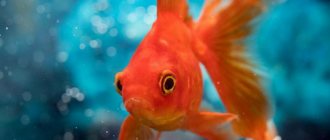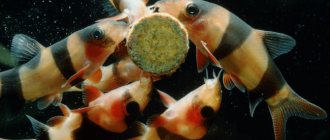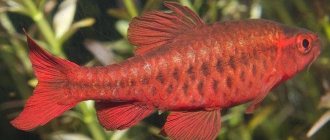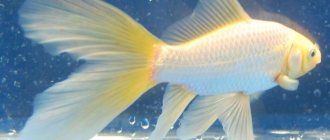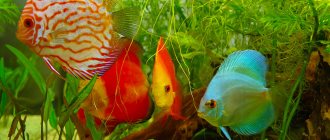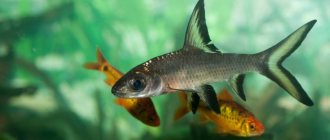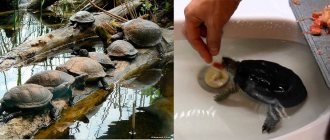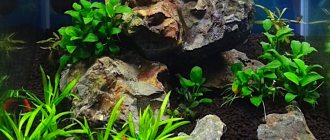Macropods, or paradise fish, were among the first to inhabit aquariums. The fish from Southeast Asia was first brought to Europe in 1869. They quickly gained popularity due to their unpretentiousness and easy reproduction.
Under natural conditions, paradise fish live in stagnant and low-flowing reservoirs. They can also often be found in rice fields. Macropods are listed in the Red Book. The decline in fish populations is associated with human development of the places where they live.
Description and natural habitat
There are 9 known species of fish, some of which were discovered quite recently. The Common Macropod lives in home tanks. Wild counterparts inhabit the waters of Southeast Asia, China, Taiwan, Vietnam, Laos, Cambodia, Malaysia, Japan and Korea.
The natural habitat is rivers and lakes with a slow flow, as well as streams and creeks; from time to time, Paradise fish swim into rice fields. They do not disdain swamps, ponds and even irrigation canals.
Photo gallery of Macropods:
Externally, macropodus is remarkable. The bright blue body with red stripes and fins attracts attention. The spindle-shaped body is flattened on the sides. The long forked tail reaches 5 cm in length. The dorsal and pectoral fins are pointed. The fish is able to breathe air and has labyrinthine breathing, so it survives in water with low oxygen levels. Living at home with sufficient tank aeration, it does not require additional breathing.
Adults grow up to 10 cm, females are smaller than males, so 8 cm is their limit. Life expectancy in a favorable environment and with proper care reaches up to 8 years.
The fish is a solitary fish and cannot stand the proximity of individuals of its own sex. Contacts with its own kind only during spawning. The rest of the time it lives in shelter under a snag or in a natural grotto, emerging only to hunt live prey. Zealously guards his home.
Reviews
Beginning aquarists, as well as hobbyists, get this fish. It is interesting to watch the inhabitant of the aquarium during spawning. There are specimens on sale with a less pronounced color, which is a consequence of crossing representatives of different species.
Mr. Tail Recommends: Macropod Varieties
There are four types of fish living in aquariums:
Macropodus opercularis
Divided into several subspecies:
| Name | Color |
| Classical | The coffee-colored body with greenish-blue stripes smoothly transitions into a deep blue tail, the head and belly are light blue. |
| Blue | Light blue body, purple head and back. |
| Albino | The white body has orange stripes, red eyes, and pinkish fins. |
| Red smooth | The head is blue, the body is brown, there are practically no stripes, all fins are red, except the pectoral ones, they are colorless. |
| Orange | The color matches the name. |
Black Macropod
It got its name because it takes on a charcoal hue when severely irritated. In a calm state, the color of the fish is gray or brown. The caudal fin is red, blue or pink. The individual is large in size, rarely found in its natural form, and most often sold as hybrids. More friendly than other varieties.
Redback
Has a characteristic body shade. The main color of the fish is silver, and under special lighting it shimmers with emerald undertones. The edges of the sky blue fins are outlined in rich white. In this species it is difficult to distinguish a female from a male; they are almost identical in color and size.
The only difference is the splendor of the male pectoral fins and tail.
Chinese (Round-tailed)
Macropod is rare in Russia. A capricious pet requires a temperature drop in winter to +15 °C. No neighbors can stand this. Life expectancy is only 4 years. Prone to bacterial diseases.
Price
The price of paradise fish depends primarily on its variety and size.
| Macropod | Average cost in rubles |
| Ordinary | 120-250 |
| Albino | 180-450 |
| Redback | 250-400 |
| Black | 310-550 |
| Chinese round-tail | 450 |
It is also important to note that some breeds are only available to order.
Aquarium Basics
Paradise fish are hardy and can live in the most unfavorable conditions - in small tanks with poor aeration and periodic temperature fluctuations.
The capacity of just over 20 liters allows you to contain one Macropod. You definitely need to install a lid, your pet loves to jump out of the water. For each individual, a separate shelter is created as far from each other as possible in order to eliminate competition for territory.
The following water quality indicators are acceptable:
| Rigidity | Acidity | Temperature |
| 5-19 °dH | 6-8 pH | +16…+26 °С |
For this species, the current should not be strong; it can be completely removed, since stagnant bodies of water are the natural habitat of fish. Replacements are made in the amount of 25% of the total volume no more than once a week.
Algae in an aquarium can be anything. They prefer greens with a developed root system and spreading along the water. For the latter, regular thinning is necessary so that the fish can rise to breathe air; this is especially true for tanks without additional aeration.
Dark soil is mandatory for Macropods; it does not irritate already restless pets and against this background they look more impressive. You should not choose artificial or painted stones to prevent contamination of the liquid with toxins and dyes. The bottom must be cleaned regularly with a siphon before changes, that is, once a week.
The aquarium equipment may be weak. Filtration is sufficient at a minimum level. Aeration and a heater may not be installed, but this is only relevant if only Macropods live in the artificial reservoir.
When choosing lighting devices, they focus on vegetation; fish do not need light. It is better to give preference to soft diffused lighting; be sure to turn off the backlight at night. The walls of the container should not be exposed to sunlight.
Appearance
Macropods grow on average up to 12 cm in aquarium conditions.
Features of the structure:
- the body is compressed and elongated;
- head with bulging eyes, snout short and pointed, medium mouth with thick lips and powerful jaws;
- unpaired fins are well developed - low, the last rays are pointed;
- the tail is often U- and V-shaped forked, long (from 3 cm), due to which labyrinths visually look even larger;
- The pelvic fins are elongated and transformed at the ends into thin threads; they serve as tactile organs, allowing excellent orientation in cloudy water.
Compatibility
Combining Paradise fish with other species is not an easy task due to their aggressive nature and certain conditions of detention. Not every neighbor is able to withstand such environmental characteristics.
In cases where an individual is reared alone, it is impossible to introduce other fish in the future. Any pet placed in the tank will be severely damaged or destroyed.
In order to accustom a Macropod to its neighbors, it is necessary to introduce fish of other species of approximately the same size to it from the age of 2 months. It is important to remember that veiled and slow-moving individuals are absolutely not suitable for combination. Even if these conditions are met, there is no guarantee that the pet will accept roommates.
If one of the community members is quarantined, it will not be possible to bring him back. Any species removed for a short time will be perceived as an enemy encroaching on its territory when it returns.
| Compatible | Incompatible |
| Barbs | Goldfish (regardless of species) |
| Danio (large species) | Sumatran barb |
| Tetras | Angelfish |
| Ancistrus | Mollies |
| Synodontis | Guppy |
| Large peaceful species | Small species, fry |
It is strictly forbidden to combine 2 males in one reservoir. Only a couple, creating as many hiding places as possible for the female.
Feeding
The predatory Macropod is not picky about its diet. To expand the diet, dry, live and frozen food is used.
For this species, the presence of carotene in food is important; a lack of this substance leads to faded color.
Recommended diet:
| Dry | Alive | Frozen |
| Tetra rubin | Bloodworm | Cyclops |
| Sera san | Koretra | Daphnia |
| Black mosquito (larva) | ||
| Bloodworm | ||
| Koretra | ||
| Moina | ||
| Shrimps |
All of these products can be combined or replaced.
History of appearance
The first copies were brought in 1869 by the French consul Simon. Unfortunately, at that time nothing was known about the need for labyrinth fish to capture air from the surface of the water, so they were transported in sealed barrels. Only 22 out of 100 fish made it out alive. The macropods were presented to the French aquarist Pierre Carbonnier, who quickly managed to breed the fish. In 1876, macropods arrived in Berlin. This marked the beginning of the widespread distribution of this species.
Depiction of macropods, 1870
Breeding
The reproduction of Paradise fish could be called simple, if not for the aggression of the male towards the females during nest construction. Preparation for spawning must be thorough; you will definitely need a separate tank with special conditions.
To start the process, the water in the main and additional aquariums is brought to the following levels:
| Rigidity | Acidity | Temperature |
| 5-19 °dH | 6 pH | +26…+29 °С |
Pets are transferred to enhanced protein nutrition using live and frozen food. The liquid level is reduced to 20 cm. Soon the female begins to gain weight, and the male begins to build a nest. At this point, it is better to keep the expectant mother away until the preparations are completed.
Failure to comply with this recommendation may result in the death of the female.
After the house is ready, the fish are reunited. The male strokes the female with his fins, inviting her to the shelter. At one time, the fish is capable of laying up to 500 eggs, which are immediately fertilized. The future offspring are so weightless that they float to the surface. The caring father collects it and hides it in the nest, which he guards with zeal until the fry appears. This usually occurs on the 5th day after spawning. The house in which the eggs were kept self-destructs, and the time comes to remove the male to the general aquarium. As soon as the babies begin to swim, the father turns into a formidable predator, capable of destroying his own offspring.
The fry are fed with special microfeeds, brine shrimp.
Nutrition
Macropods are omnivores, but most of them eat food of animal origin. In their natural environment, they consume insects, life-giving larvae, small fish fry, and earthworms.
In aquarium conditions, select dry, balanced food for macropods. It has an increased safety indicator, unlike live frozen food. Macropods happily consume flake foods such as TetraMin. Specimens will readily try balanced pellets. To add brightness to the color, use food with a high content of natural color enhancers in the daily diet of fish.
Tetramine for feeding macropod fish
The diet of each macropod must include plant nutrition. For this purpose, food with a high content of beneficial spirulina algae, for example, TetraPro Algae, is useful.
Advice! Pamper your aquarium pets by sometimes giving them popular jelly food. They will be an excellent alternative to frozen substances. You can also let the fish try bloodworms, daphnia, and brine shrimp.
Macropod aquarium fish are prone to excessive overeating, so give balanced food in portions. This representative of the aquatic world will help destroy flatworms and small snails, cleaning the aquarium.
Make sure that the labyrinth diet contains the following nutritional components:
- Koretra, feeding tubifex, caught live bloodworm;
- Dry granulated food in the form of flakes; to give additional brightness to the color of labyrinths, mixtures based on active carotene are given;
- In addition, they provide natural bloodworm larvae, black mosquito, crushed daphnia, chopped shrimp, which are brought to room temperature before serving;
- Occasionally, a homemade substance made from uniform minced meat based on natural seafood is introduced into the daily diet.
Live varieties must be disinfected in a ready-made solution of potassium permanganate. Feeding is carried out twice a day. Aquarists call the labyrinth fish a natural orderly. She happily gets rid of excess hydras, aquarium planaria, and easily eats snails that reproduce at a rapid pace.
Natural bloodworm larvae
During feeding, the fish slowly moves towards the supplied live food, as if making an attempt to examine its future target, then suddenly rushes, rushing at the chosen prey. If his “object” is three-dimensional, with the same intermittent movements he will tear it into small pieces.
It is fascinating to watch this process by throwing any living insect onto the water surface, for example, a caught fly - after careful inspection, the fish will perform several sharp jerks, and then the selected prey will be captured under the water column, where it will be completely torn into small pieces and eaten.
Diseases and prevention
The living conditions of Macropods in nature are so extreme that their immune system is able to overcome any disease. Problems can only appear in weakened individuals with improper maintenance and poor care.
It is worth paying attention to your pet if it hides in unusual places or swims more slowly. Compressed fins, swaying left and right, and scratching against rocks are alarming. The most dangerous symptoms are loss of appetite and pale color.
Sometimes a sick individual is brought into the aquarium, which infects the others, and this is how lymphocytosis is transmitted. The crustacean parasite that causes the disease causes tumors to appear throughout the body. Initially they are small, but grow at high speed and gradually cover the entire body. Over time, the nodular growths burst and the wounds heal.
A rare disease of the Paradise fish, fin rot, occurs as a result of improper care and low water temperature. It begins with shortening and twisting of the fin and leads to their complete destruction.
A common disease of Macropods is microbacteriosis. It expresses itself in damage to the skin and scales. Sites of infection become red and inflamed, and dark spots appear throughout the body. If you suspect that your pet is sick, you should contact an ichthyologist. Only a doctor can make a diagnosis and select the right drug for treatment.
Interesting Facts
Despite the wide geography of its habitat, the unique fish managed to get into the Red Book. This is due to active human pollution of the places where it exists. There is no risk of extinction of the Macropod yet, but as a precaution and for protection, the fish was included in the lists of potentially vulnerable species.
Macropod spawning is dangerous for males and threatens exhaustion and death. Therefore, it is not recommended to allow more than 3 reproduction processes in a row. For females, on the contrary, a long absence of spawning is contraindicated; they collect eggs and, if they do not shed them for a long time, diseases of the reproductive organs begin to occur. To regulate reproduction, it is recommended to periodically create a strong current in the aquarium and increase the light. It would be optimal to keep several males, but each of them needs a separate pond.
Behavior
There are many myths about the behavior of macropods, especially classical ones. They say they are pugnacious, pick up all the fish indiscriminately, fight among themselves and kill the females.
This is wrong. Normally, macropods do not behave this way, otherwise how would they survive in nature. Yes, among them there are also very vicious and aggressive individuals, capable of killing both the female after spawning and their own fry. Therefore, such fish should not be allowed into breeding. Macropods get along well with other comparable and larger non-aggressive fish if the aquarium is of sufficient size and there is an abundance of shelters and living plants. Yes, they can bite and even eat smaller and more sedentary veiled fish, but they are predators and there is nothing unusual in such behavior. Normally, a macropod is a bold, cocky, lively fish. Passivity and timidity are uncharacteristic of a classical macropod. The most active macropods are classic and blue colors. The calmest ones are albinos, white and orange; they should not be planted in the same aquarium with classic ones.
